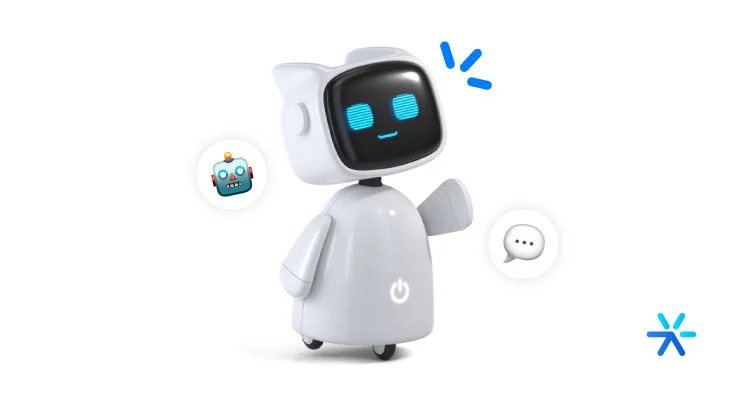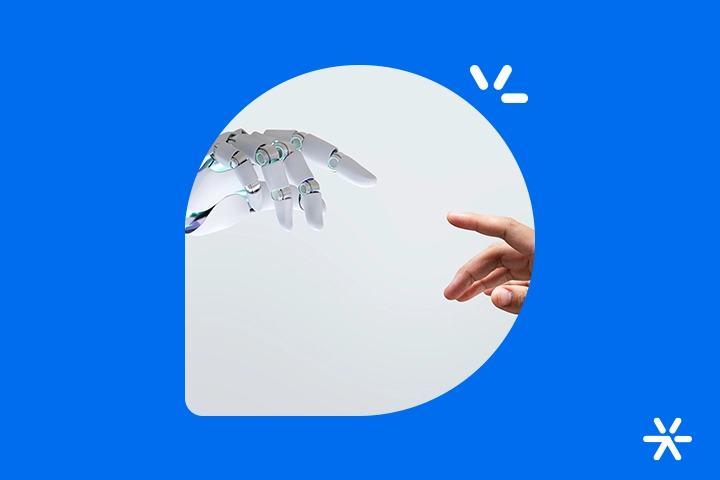Artificial Intelligence in 2024: What to Expect
What can we expect from the development of Artificial Intelligence in 2024?
Every now and then, we set aside performance here on the blog a bit to speak from the heart.
This is one of those cases.
It’s cool and extremely important to write articles with organic traffic in mind, planning keywords to ensure we always appear on the first page.
But, at the same time, some subjects cannot be approached with such a strategic mindset because they are too important.
This is the case with Artificial Intelligence in 2024. We’ve spent the last few years following its development and hearing big promises about its use.
Have they materialized? Will they still materialize?
That’s what we’re going to talk about today. No strings attached. What do you say?
Everything we’ve talked about regarding Artificial Intelligence
Before we dive into the topic completely, here are all our articles about Artificial Intelligence, both in digital marketing and beyond — in society in general and in business.
➡️ChatGPT Prompts for Marketing: 50 examples for B2B and B2C
➡️The Positive Aspects of Artificial Intelligence. And the other ones.
➡️What is Artificial Intelligence and How to Apply it to your Business
➡️Artificial Intelligence Chatbot: The 8 Best on the Market
➡️18 image creating AI tools with results and examples!
AI has grown in a super interesting way. Instead of having one large platform, we have various dispersed uses across different brands.
As a result, you can now find specific AI platforms for various segments in marketing.
This is where the fundamental importance of knowing its main purposes — and understanding its limitations — comes in.
Working with AI is already a reality. There has never been room for Luddites in digital marketing.
If you feel like you don’t fully understand how AI works and its applications in digital marketing, really read these articles. Like, really.
I understand that reading them all will take up your entire day. They’re pretty much a book.
But it’s better to use them as an instruction manual. When you’re unsure about something specific, open one of these articles for some extra help!
Ok, now where were we?
What are the limitations of AI in 2024?

Now that the frenzy of the big launches in 2023 has passed, we can see more clearly the dimension of these tools and understand what they can and cannot do.
This is the most important point in understanding AI. Due to the aggressive marketing strategy of the major AI developers — especially Google and OpenAI — many people have overly optimistic or pessimistic views about it.
The optimists imagine that it will completely revolutionize the market, that it will reach a level where work itself will be redundant — AI does everything.
The pessimists believe the same thing: that AI will dominate the market and that we humans will all be replaced soon.
So, where does the truth lie?
It lies somewhere between pessimism and optimism, as always. And that’s what we’ll see in 2024: a “general awakening,” the possibility of seeing beyond the hype and understanding AI’s place in the job market.
Here, to start the conversation, we’ll discuss the limitations and challenges that AI will face throughout 2024.
Still with me?
Processing power and the environment: the dilemma
One of the main challenges of AI today is increasing its processing power.
All generative AI models are very costly in this aspect. OpenAI’s data centers are gigantic, and for your Artificial Intelligence to keep growing, they also need to expand more and more.
As Artificial Intelligence develops more and more, this point becomes increasingly difficult to solve.
Firstly, of course, due to the business model of the major AI developers worldwide.
OpenAI depends heavily on its investments and contracts to continue this mission. Its strategy is mainly focused on licensing the GPT-4 model for other companies to create their products.
As a result, in 2024, OpenAI surpassed $2 billion in revenue last year, according to Reuters, and plans to double that value by 2025.
Another challenging point is navigating the ethical sea of building so many data centers in the world we live in today.
The carbon footprint of these data centers is quite large. What Artificial Intelligence will face in 2024 is the challenge of creating positive impacts on the environment despite its high emissions.
For example: creating a governance plan with advanced data analysis can reduce a country’s carbon footprint by levels greater than that of the data centers themselves.
Regulatory issues and lawsuits
Artificial Intelligence in 2024 will likely face some very complicated regulatory points.
Points that we can’t even imagine yet what they might be.
For any AI to function, it needs a database. And this database has been aggregating content from the internet.
For example: in early 2023, DeviantArt users sued Stability AI, Midjourney, and DeviantArt itself for training generative image models with their artwork.
If you’re not familiar with the site, DeviantArt is a social network for artists who share their creations there. The problem arose when AIs started being trained without the artists’ consent using the site’s database.
This even led to a joint lawsuit that is still in the courts today.
Another case was The New York Times versus OpenAI. In 2023, the newspaper alleged that AI used millions of Times articles for training and is now competing with it in generating journalistic texts.
Regulations have not even been rehearsed for Artificial Intelligence. Navigating this dubious legal landscape will be a major task for AI tools throughout 2024.
Clones in the market
We have an article here on the blog that features 18 AI tools. And we have many other articles with specific tools for various roles in digital marketing.
And, analyzing all these tools, we noticed that many of them fall into the “clone” category.
Clones are normal in the SaaS market. There are clones of practically every product available online.
This is a challenge for AI because it becomes increasingly difficult to convey the qualities of your product when there are ten others just like it.
And it also becomes difficult for us, consumers of these products, to choose the best among so many options.

What can we expect from AI in 2024?

Artificial Intelligence still has a lot of ground to cover in the market. And it’s now, in 2024, that it will take the first steps towards complete domination.
This is neither a prediction nor wishful thinking: all paths, at this moment, point to AI.
That’s precisely why we need to situate ourselves. We need to understand AI’s challenges and successes, and plan to both.
Still with me?
Increasingly specific tools
We touched on this issue a bit throughout the article, but we need to focus more on it now.
In 2024, Artificial Intelligence will expand even further. New models are emerging, new applications of it are appearing; in short, its uses are diversifying as technology develops.
This creates a great market opportunity for new brands and startups that use AI. We ourselves here at Leadster have a functionality with ChatGPT.
There are already AIs that create all the creatives for your ads. There are also those that analyze your data and provide tips to improve them operationally.
There are AIs that produce content, but there are also those that do keyword research and SERP analysis, without involving production.
There are AIs that produce images and AIs that produce entire posts. And there are AIs focused on direct customer service.
Every area of digital marketing already has its AIs at work. And the bet is that in 2024, this evolution will become even more evident.
Companies seeking AI experts
As AI develops in these niches of digital marketing, it becomes increasingly complicated to operate them and stay updated with all their tools.
Therefore, one of the bets for 2024 is that companies will increasingly need people who understand Artificial Intelligence for their marketing departments and beyond.
There is already a movement within companies to train their workers with AI, something essential for the moment we are living in.
But even so, there are also professionals who are specializing on their own, seeking to improve their resumes and search for these specific vacancies that will arise throughout the year.
Growth limitations due to energy needs
Now a problem: AI’s first crisis was related to the limits that data centers had.
But this was reduced with investments and the expansion of the server network that labs have.
However, we have another problem: the larger the data centers, the more energy they consume.
A major challenge for AIs is ensuring that this energy reaches their servers without interruptions.
To give you an idea of the extent of the problem, take a look:
Today, the most sought-after country for server farms is Ireland, due to its tax incentives for startups.
However, almost a fifth of Ireland’s electricity is now going to data centers. And, of that energy, 20% is dedicated entirely to AI.
This is extremely difficult to sustain for a long time, since the main philosophy of Artificial Intelligence in 2024 is expansion.
We will see this movement unfold throughout the year: either a reduction in the growth of platforms or a search, along with local governments, for a reduction in energy costs.
The end of the tech-hype cycle
The world of startups — especially that of big startups — revolves around hype.
Hype is, for those not familiar with the term, an expectation of success.
All products created by the major technology startups in Silicon Valley use hype as a marketing technique.
You noticed this with ChatGPT. As soon as it was launched, everyone was talking about it and its possibilities.
This is all product marketing strategy. And whenever a new product emerges, it goes through this cycle to gain traction in the global market.
2023 was hype year for AI. 2024 is results year.
It will be this year that all its declared uses will be put to the test. And we, its users, will finally understand once and for all if AI is really all that it’s said to be.
Bigger and better models
The end of the hype cycle of Artificial Intelligence also brings opportunities.
The challenge of overcoming it involves developing increasingly larger and more robust technologies.
This is the case with Sora, from OpenAI, launched earlier in 2024. It is capable of producing complete videos, including camera movements, using only prompts.
But there’s already a limitation: Sora doesn’t produce videos in full-HD, a huge need for everyone working in digital marketing.
At this moment, the race of AIs is still in the field of generative AI, like ChatGPT, Midjourney, DALL-E 2, Stability, etc.
These are the main models of Natural Language Processing and Image Processing today, and they are the ones we should keep an eye on to understand what the future will really be like.
Attention to other technologies — positive and negative
2024 will also inaugurate some very controversial uses of AI, going well beyond the generative and NLP.
These uses involve technologies such as facial recognition, control of autonomous drones, autonomous cars, social data analysis for advertising, etc.
All of this is still not regulated in most of the world.
And we’ve seen the problems that can occur when an unregulated technology emerges into the world like this, in haste: people have been harmed by AI and are suing labs and startups.
These different AI technologies raise the problem to social levels. Facial recognition is trained, and it can end up targeting one segment of the population more than another.
Throughout the year, debates will intensify around this issue. All we can do is wait and hope that its uses are ethical and, above all, accountable.
What are the main practical points of AI today?

Talking about the future of Artificial Intelligence in 2024 and beyond is a challenge: everything is very uncertain, and there are factors that go beyond technology.
This includes ethical limits, processing limits, the increasing demand for energy, and so on.
One of the best ways to understand the future of AI for digital marketing is by analyzing what it’s already doing today.
Its practical applications, its main uses in everyday life that are already applicable to anyone today.
With that in mind, it becomes easier to understand the practical side of where AI is aiming in 2024.
In this part of the article, I’ll talk about some uses of Artificial Intelligence that are already popular in the market, showing also what the expected evolution of each of these tools will be for 2024.
Ready?
Content creation
By far, the Artificial Intelligence tools in 2024 that you will see the most are those focused on content creation.
This is because they are the simplest to create. Perplexity.AI is currently the most popular among content teams worldwide.
These tools are easy to create because they are entirely based on an existing NLP model, with development focused on the other functionalities of the product.
The biggest advancement that content-creating AIs will have in 2024 will certainly be in these different resources.
For example: Perplexity lets you choose the NLP model you want to use and allows advanced editing of prompts.
These are the features that will see more development in 2024 on these platforms, since those related to NLP models themselves are the responsibility of the labs.
Customer service
Tied for first place in the ranking of most popular AIs are those focused on customer service.
But here, there are several different types of AIs, each bringing different approaches to customer service.
For example: there are AIs that help the agent during the service. But there are also AIs that work themselves by performing initial service.
The most popular so far is Zendesk’s platform, which offers these two functionalities — and a few more as well — like responses on social networks.
For 2024, we can expect even greater advancement in these service AIs since they are not “stuck” to the limitations of NLP models but to the advances of the proprietary technologies that make them work.
Video creation
As we’ve seen, video creation is also a specialty of Artificial Intelligence in 2024.
Yes, in 2024 itself: before this year, there was no AI capable of doing what Sora is doing.
It is very likely that, as OpenAI continues to release Sora to businesses — just like ChatGPT — we will start to see a large number of platforms entirely focused on videos using AI.
This is the bet for generative video AI in 2024 from this writer. But as everything is still in its infancy, I may be wrong.
Leave your opinion in the comments!
Lead generation
Artificial Intelligence for lead generation is also a big reality today and will continue to be throughout 2024.
The main exponent of this use has been Leadster. Yes, ourselves! 😅
Leadster has a functionality with ChatGPT, allowing you to create calls for your chatbots using AI.
It works quite simply: you install Leadster, and it starts to understand which of your pages are most visited.
Then, you’ll have access, directly on your dashboard, to a list of your most popular pages on the entire site.
Just this functionality alone is quite interesting, right? But it gets even better.
With this ready listing, you have the option to create flows with these pages, with ChatGPT creating the calls for each of them.
This saves you a lot of time overall since you won’t even need to read any of the pages: ChatGPT reads them and offers the best call for that topic.
Test it today! It’s free and no credit card required.







